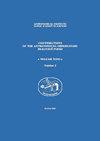磁活动食双星DV Psc的时间演化
IF 0.2
4区 物理与天体物理
Q4 ASTRONOMY & ASTROPHYSICS
Contributions of the Astronomical Observatory Skalnate Pleso
Pub Date : 2020-03-01
DOI:10.31577/caosp.2020.50.2.521
引用次数: 0
摘要
在食双星DV Psc上磁活动的存在已经被发现近二十年了。然而,直到最近,还没有发现与这种活动有关的周期性行为的证据。在这项研究中,利用DV Psc的长期光度观测来分析系统的磁活动,寻找可能的磁周期,并确定轨道和物理参数。光度和光谱学观测的结合产生了一个统一的模型,该模型根据可变的光斑活动描述了该系统随时间的变化。确定了新的最小光期,并构建了准确的天文历表和更新的O-C图,总跨度为19年(1997-2017)。强烈的磁活动,如光曲线的强烈不对称性(奥康奈尔效应)所表明的,以及O- c图的周期性变化相结合来解释系统的行为。第三个天体的存在,以偏心轨道绕食双星运行,以及磁循环是最有可能的情况。本文章由计算机程序翻译,如有差异,请以英文原文为准。
Temporal evolution of the magnetically active eclipsing binary DV Psc
The existence of magnetic activity on the eclipsing binary DV Psc has been known for almost two decades. However, until recently, no evidence of periodic behaviour relevant to this activity had been found. In this study, long-term photometric observations of DV Psc are used to analyze the system’s magnetic activity, seek a possible magnetic cycle and determine orbital and physical parameters. The combination of photometric and spectroscopic observations results in a unified model that describes the system over time in terms of variable spot activity. New times of minimum light are determined and an accurate astronomical ephemeris and updated O-C diagram are constructed for a total span of 19 years (1997-2017). The intense magnetic activity, as indicated by strong asymmetries in the light curves (O’ Connell effect), and the periodic variation of the O-C diagram are combined to explain the system’s behaviour. The existence of a third body, orbiting the eclipsing binary in an eccentric orbit, as well as a magnetic cycle are the most likely scenario.
求助全文
通过发布文献求助,成功后即可免费获取论文全文。
去求助
来源期刊
CiteScore
1.10
自引率
20.00%
发文量
4
审稿时长
>12 weeks
期刊介绍:
Contributions of the Astronomical Observatory Skalnate Pleso" (CAOSP) is published by the Astronomical Institute of the Slovak Academy of Sciences (SAS). The journal publishes new results of astronomical and astrophysical research, preferentially covering the fields of Interplanetary Matter, Stellar Astrophysics and Solar Physics. We publish regular papers, expert comments and review contributions.

 求助内容:
求助内容: 应助结果提醒方式:
应助结果提醒方式:


